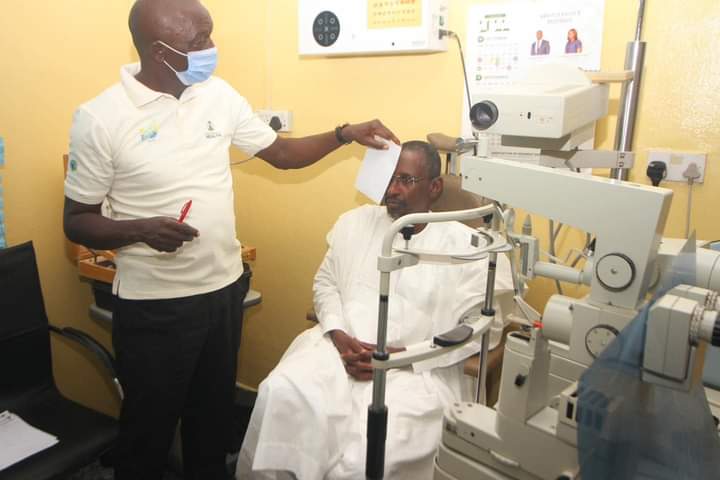Thursday 13th of October, 2002, was the World Sight Day (WSD).
World Sight Day is a day set aside by the International Agency for Prevention of Blindness (IAPB) and the World Health Organization (WHO) to create awareness on avoidable blindness, visual impairments and the importance of eye care.
The theme of this year’s celebration is “LOVE YOUR EYES”.
World Sight Day draws attention to a range of issues surrounding visual impairments/blindness. It is seen as one of the most important days for communication and advocacy on eye care.
World Sight Day is under the Vision 2020 -The Right to Sight global initiative, whose objective is to promote a world in which nobody is needlessly blind or visually impaired.
The aims of World Sight Day are;
1.To raise awareness of issues surrounding blindness and visual impairment.
2. Advocacy to influence or draw Governments’ attention worldwide to participate in and donate funds to blindness prevention programs, recruitment of eye health personnel, etc.
3. To garner support for impactful vision programs and activities, and
5. To raise awareness on the prevention of blindness.
Globally, the common causes of visual impairments are:
(a) Uncorrected Refractive Errors: They include myopia or otherwise known as short-sightedness, hyperopia or otherwise known as long-sightedness, and astigmatism. Presbyopia is an eye condition associated with vision loss due to age.
(b) Short-sightedness or myopia makes far objects look blurry, hyperopia or long-sightedness makes nearby objects look blurry, and astigmatism can also make both near and far objects look distorted. Presbyopia on the other hand makes it difficult for middle-aged and older adults to see tiny prints or other objects at close range.
(b). Cataracts: this is a clouding of the natural lens of the eyes and it’s one of the causes of blindness worldwide, and a major cause of vision loss in Africa. Cataracts can occur at any age in life because of varieties of causes, and can also be present at birth.
(c) Age-related Macular Degeneration: is a disease that affects a person’s central vision. It can result in severe central vision loss. Risk factors for Age-related Macular Degeneration include being 50 and above in age, smoking, having High Blood Pressure and eating a diet in saturated fats.
(d) Glaucoma: refers to a group of eye conditions that damage the optic nerve. The optic nerve sends visual information from the eye to the brain and it is vital for good vision. Damages to the optic nerve are often connected to high intraocular pressures of the eyes. But some types of glaucoma can still occur with normal eye pressure hence the need for regular eye check ups. This condition may be hereditary and it’s common in adult blacks. Most times, it’s symptomless hence referred to as the silent thief of sight. Blindness from glaucoma is irreversible
(e) Diabetic Retinopathy: is a complication of diabetes caused by high blood sugar levels damaging the back of the eye known as retina. It can cause blindness if left undiagnosed/untreated.
(f) Corneal Opacity: refers to the eye condition arising when the cornea becomes scarred thus preventing light from passing through the cornea to the retina which may cause the cornea to appear whitish or cloudy. Cornea Opacity is mainly caused by injuries, corneal abrasion, infection or scratch
(g) Trachoma: is basically a bacterial infection that affects the eyes. It’s a contagious disease caused by the bacterium Chlamydia trachomatis. It spreads through contacts with the eyes, eyelids and nose or throat secretions of an infected person. It is associated with poor socioeconomic conditions such as places where safe water is scarce, poor personal hygiene and environmental sanitations. Eye-seeking flies and contaminated hands, fomites or clothing transmit the bacteria between people from the nasal or ocular discharge of infected persons. Undiagnosed, untreated and even poor management of trachoma can lead to severe visual impairments and resultant blindness.
The above are just simple definitions of the common conditions/diseases that can lead to visual impairments and should not replace proper professional clinical consultations and annual regular examinations or make people result to the temptation and practice of self-medications by going to the chemist or pharmacy to buy eye medications without the doctor’s prescription and going to road sides/ market places to buy reading glasses from quacks without the Optometrist’ prescription. Please also note that there are other conditions or diseases that can cause visual impairments.
Nigerian Optometric Association, an active member of the National Eye Health Committee will be collaborating with Ophthalmological Society of Nigeria (OSN), Nigerian Ophthalmic Nurses Association (NONA) and Association of Nigerian Dispensing Opticians (ANDO) to mark this year’s World Sight Day





